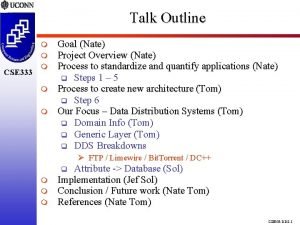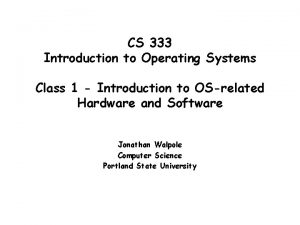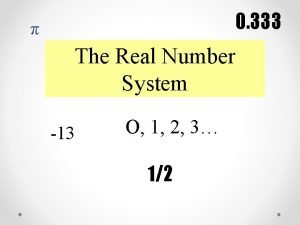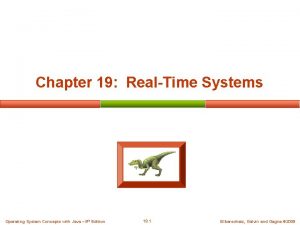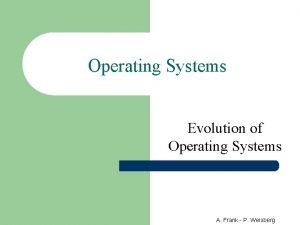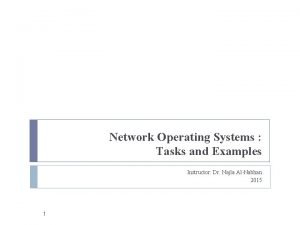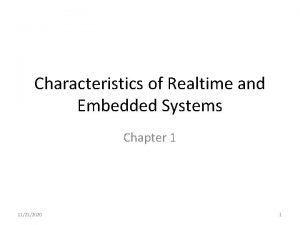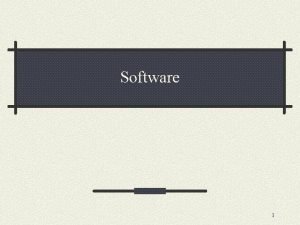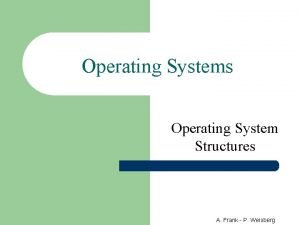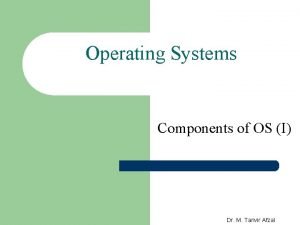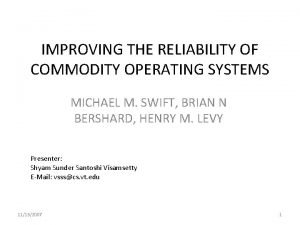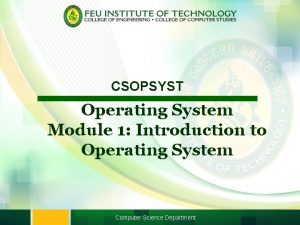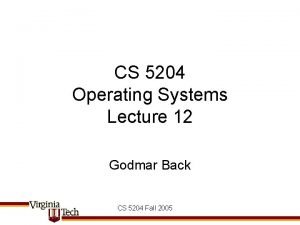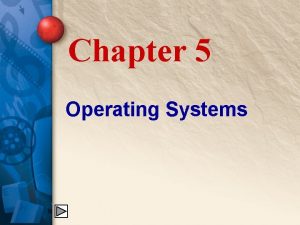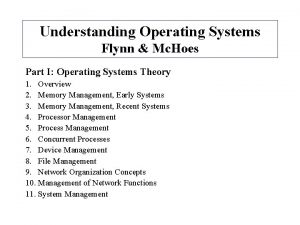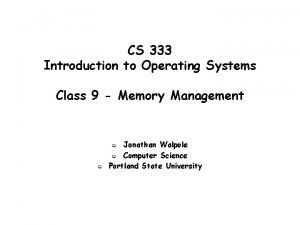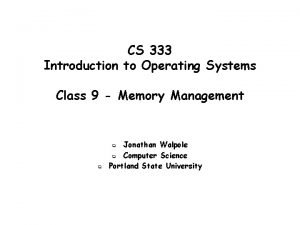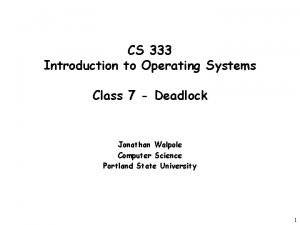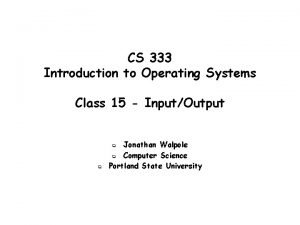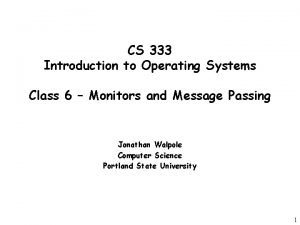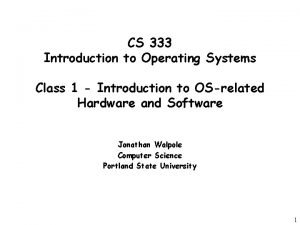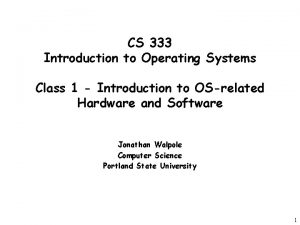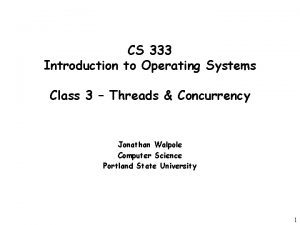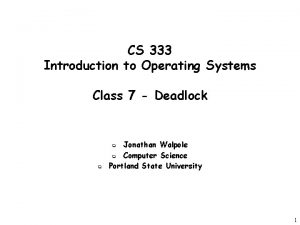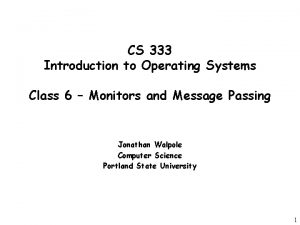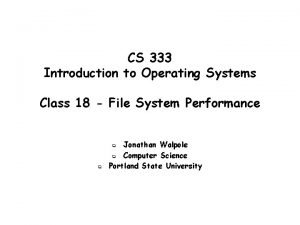CS 333 Introduction to Operating Systems Class 5

















































![Taking chopsticks int state[N] semaphore mutex = 1 semaphore sem[i] take_chopsticks(int i) { wait(mutex); Taking chopsticks int state[N] semaphore mutex = 1 semaphore sem[i] take_chopsticks(int i) { wait(mutex);](https://slidetodoc.com/presentation_image/1f8f9a39cf776c294b4befbd0ab19681/image-50.jpg)
![Putting down chopsticks int state[N] semaphore mutex = 1 semaphore sem[i] put_chopsticks(int i) { Putting down chopsticks int state[N] semaphore mutex = 1 semaphore sem[i] put_chopsticks(int i) {](https://slidetodoc.com/presentation_image/1f8f9a39cf776c294b4befbd0ab19681/image-51.jpg)











- Slides: 62

CS 333 Introduction to Operating Systems Class 5 – Semaphores and Classical Synchronization Problems Jonathan Walpole Computer Science Portland State University 1

An Example Synchronization Problem 2

The Producer-Consumer Problem q An example of the pipelined model v v q q Use a bounded buffer between the threads The buffer is a shared resource v q q One thread produces data items Another thread consumes them Code that manipulates it is a critical section Must suspend the producer thread if the buffer is full Must suspend the consumer thread if the buffer is empty 3

Is this busy-waiting solution correct? thread producer { while(1){ // Produce char c while (count==n) { no_op } buf[In. P] = c In. P = In. P + 1 mod n count++ } } n-1 0 1 … 2 thread consumer { while(1){ while (count==0) { no_op } c = buf[Out. P] Out. P = Out. P + 1 mod n count-// Consume char } } Global variables: char buf[n] int In. P = 0 // place to add int Out. P = 0 // place to get int count 4

This code is incorrect! q The “count” variable can be corrupted: v v Increments or decrements may be lost! Possible Consequences: • Both threads may spin forever • Buffer contents may be over-written q What is this problem called? 5

This code is incorrect! q The “count” variable can be corrupted: v v Increments or decrements may be lost! Possible Consequences: • Both threads may sleep forever • Buffer contents may be over-written q q What is this problem called? Race Condition Code that manipulates count must be made into a ? ? ? and protected using ? ? ? 6

This code is incorrect! q The “count” variable can be corrupted: v v Increments or decrements may be lost! Possible Consequences: • Both threads may sleep forever • Buffer contents may be over-written q q What is this problem called? Race Condition Code that manipulates count must be made into a critical section and protected using mutual exclusion! 7

Some more problems with this code q What if buffer is full? v v q What if buffer is empty? v v q Producer will busy-wait On a single CPU system the consumer will not be able to empty the buffer Consumer will busy-wait On a single CPU system the producer will not be able to fill the buffer We need a solution based on blocking! 8

Producer/Consumer with Blocking – 1 st attempt 0 thread producer { 1 while(1) { 2 // Produce char c 3 if (count==n) { 4 sleep(full) 5 } 6 buf[In. P] = c; 7 In. P = In. P + 1 mod n 8 count++ 9 if (count == 1) 10 wakeup(empty) 11 } 12 } n-1 0 1 … 2 0 thread consumer { 1 while(1) { 2 if(count==0) { 3 sleep(empty) 4 } 5 c = buf[Out. P] 6 Out. P = Out. P + 1 mod n 7 count--; 8 if (count == n-1) 9 wakeup(full) 10 // Consume char 11 } 12 } Global variables: char buf[n] int In. P = 0 // place to add int Out. P = 0 // place to get int count 9

Use a mutex to fix the race condition in this code 0 thread producer { 1 while(1) { 2 // Produce char c 3 if (count==n) { 4 sleep(full) 5 } 6 buf[In. P] = c; 7 In. P = In. P + 1 mod n 8 count++ 9 if (count == 1) 10 wakeup(empty) 11 } 12 } n-1 0 1 … 2 0 thread consumer { 1 while(1) { 2 if(count==0) { 3 sleep(empty) 4 } 5 c = buf[Out. P] 6 Out. P = Out. P + 1 mod n 7 count--; 8 if (count == n-1) 9 wakeup(full) 10 // Consume char 11 } 12 } Global variables: char buf[n] int In. P = 0 // place to add int Out. P = 0 // place to get int count 10

Problems q q Sleeping while holding the mutex causes deadlock ! Releasing the mutex then sleeping opens up a window during which a context switch might occur … again risking deadlock How can we release the mutex and sleep in a single atomic operation? We need a more powerful synchronization primitive 11

Semaphores q An abstract data type that can be used for condition synchronization and mutual exclusion What is the difference between mutual exclusion and condition synchronization? 12

Semaphores q q An abstract data type that can be used for condition synchronization and mutual exclusion Condition synchronization v v q wait until condition holds before proceeding signal when condition holds so others may proceed Mutual exclusion v only one at a time in a critical section 13

Semaphores q An abstract data type v v q Alternative names for the two operations v v q containing an integer variable (S) Two operations: Wait (S) and Signal (S) Wait(S) = Down(S) = P(S) Signal(S) = Up(S) = V(S) Blitz names its semaphore operations Down and Up 14

Classical Definition of Wait and Signal Wait(S) { while S <= 0 do noop; S = S – 1; } /* busy wait! */ /* S >= 0 */ Signal (S) { S = S + 1; } 15

Problems with classical definition q Waiting threads hold the CPU v v Waste of time in single CPU systems Required preemption to avoid deadlock 16

Blocking implementation of semaphores Semaphore S has a value, S. val, and a thread list, S. list. Wait (S) S. val = S. val - 1 If S. val < 0 { add calling thread to S. list; block; } /* negative value of S. val */ /* is # waiting threads */ /* sleep */ Signal (S) S. val = S. val + 1 If S. val <= 0 { remove a thread T from S. list; wakeup (T); } 17

Implementing semaphores q Wait () and Signal () are assumed to be atomic How can we ensure that they are atomic? 18

Implementing semaphores q Wait () and Signal () are assumed to be atomic How can we ensure that they are atomic? q Implement Wait() and Signal() as system calls? v v how can the kernel ensure Wait() and Signal() are completed atomically? Same solutions as before • Disable interrupts, or • Use TSL-based mutex 19

Semaphores with interrupt disabling struct semaphore { int val; list L; } Wait(semaphore sem) DISABLE_INTS sem. val-if (sem. val < 0){ add thread to sem. L sleep(thread) } ENABLE_INTS Signal(semaphore sem) DISABLE_INTS sem. val++ if (sem. val <= 0) { th = remove next thread from sem. L wakeup(th) } ENABLE_INTS 20

Semaphores with interrupt disabling struct semaphore { int val; list L; } Wait(semaphore sem) DISABLE_INTS sem. val-if (sem. val < 0){ add thread to sem. L sleep(thread) } ENABLE_INTS Signal(semaphore sem) DISABLE_INTS sem. val++ if (sem. val <= 0) { th = remove next thread from sem. L wakeup(th) } ENABLE_INTS 21

Blitz code for Semaphore. wait method Wait () var old. Int. Stat: int old. Int. Stat = Set. Interrupts. To (DISABLED) if count == 0 x 80000000 Fatal. Error ("Semaphore count underflowed during 'Wait‘ operation") End. If count = count – 1 if count < 0 waiting. Threads. Add. To. End (current. Thread) current. Thread. Sleep () end. If old. Int. Stat = Set. Interrupts. To (old. Int. Stat) end. Method 22

Blitz code for Semaphore. wait method Wait () var old. Int. Stat: int old. Int. Stat = Set. Interrupts. To (DISABLED) if count == 0 x 80000000 Fatal. Error ("Semaphore count underflowed during 'Wait‘ operation") End. If count = count – 1 if count < 0 waiting. Threads. Add. To. End (current. Thread) current. Thread. Sleep () end. If old. Int. Stat = Set. Interrupts. To (old. Int. Stat) end. Method 23

Blitz code for Semaphore. wait method Wait () var old. Int. Stat: int old. Int. Stat = Set. Interrupts. To (DISABLED) if count == 0 x 80000000 Fatal. Error ("Semaphore count underflowed during 'Wait‘ operation") End. If count = count – 1 if count < 0 waiting. Threads. Add. To. End (current. Thread) current. Thread. Sleep () end. If old. Int. Stat = Set. Interrupts. To (old. Int. Stat) end. Method 24

Blitz code for Semaphore. wait method Wait () var old. Int. Stat: int old. Int. Stat = Set. Interrupts. To (DISABLED) if count == 0 x 80000000 Fatal. Error ("Semaphore count underflowed during 'Wait‘ operation") End. If count = count – 1 if count < 0 waiting. Threads. Add. To. End (current. Thread) current. Thread. Sleep () end. If old. Int. Stat = Set. Interrupts. To (old. Int. Stat) end. Method 25

But what is current. Thread. Sleep ()? q If sleep stops a thread from executing, how, where, and when does it return? v v q which thread enables interrupts following sleep? the thread that called sleep shouldn’t return until another thread has called signal ! … but how does that other thread get to run? … where exactly does the thread switch occur? Trace down through the Blitz code until you find a call to switch() v v Switch is called in one thread but returns in another! See where registers are saved and restored 26

Look at the following Blitz source code q Thread. c v v q Thread. Sleep () Run (next. Thread) Switch. s v Switch (prev. Thread, next. Thread) 27

Blitz code for Semaphore. signal method Signal () var old. Int. Stat: int t: ptr to Thread old. Int. Stat = Set. Interrupts. To (DISABLED) if count == 0 x 7 fffffff Fatal. Error ("Semaphore count overflowed during 'Signal' operation") end. If count = count + 1 if count <= 0 t = waiting. Threads. Remove () t. status = READY ready. List. Add. To. End (t) end. If old. Int. Stat = Set. Interrupts. To (old. Int. Stat) end. Method 28

Blitz code for Semaphore. signal method Signal () var old. Int. Stat: int t: ptr to Thread old. Int. Stat = Set. Interrupts. To (DISABLED) if count == 0 x 7 fffffff Fatal. Error ("Semaphore count overflowed during 'Signal' operation") end. If count = count + 1 if count <= 0 t = waiting. Threads. Remove () t. status = READY ready. List. Add. To. End (t) end. If old. Int. Stat = Set. Interrupts. To (old. Int. Stat) end. Method 29

Blitz code for Semaphore. signal method Signal () var old. Int. Stat: int t: ptr to Thread old. Int. Stat = Set. Interrupts. To (DISABLED) if count == 0 x 7 fffffff Fatal. Error ("Semaphore count overflowed during 'Signal' operation") end. If count = count + 1 if count <= 0 t = waiting. Threads. Remove () t. status = READY ready. List. Add. To. End (t) end. If old. Int. Stat = Set. Interrupts. To (old. Int. Stat) end. Method 30

Blitz code for Semaphore. signal method Signal () var old. Int. Stat: int t: ptr to Thread old. Int. Stat = Set. Interrupts. To (DISABLED) if count == 0 x 7 fffffff Fatal. Error ("Semaphore count overflowed during 'Signal' operation") end. If count = count + 1 if count <= 0 t = waiting. Threads. Remove () t. status = READY ready. List. Add. To. End (t) end. If old. Int. Stat = Set. Interrupts. To (old. Int. Stat) end. Method 31

Semaphores using atomic instructions q q Implementing semaphores with interrupt disabling only works on uni-processors v What should we do on a multiprocessor? As we saw earlier, hardware provides special atomic instructions for synchronization v v v q test and set lock (TSL) compare and swap (CAS) etc Semaphore can be built using atomic instructions 1. build mutex locks from atomic instructions 2. build semaphores from mutex locks 32

Building spinning mutex locks using TSL Mutex_lock: TSL REGISTER, MUTEX CMP REGISTER, #0 JZE ok JMP mutex_lock Ok: RET Mutex_unlock: MOVE MUTEX, #0 RET | | | copy mutex to register and set mutex to 1 was mutex zero? if it was zero, mutex is unlocked, so return try again return to caller; enter critical section | store a 0 in mutex | return to caller 33

Using Mutex Locks to Build Semaphores q How would you modify the Blitz code to do this? 34

What if you had a blocking mutex lock? Problem: Implement a counting semaphore Up () Down (). . . using just Mutex locks q Goal: Make use of the mutex lock’s blocking behavior rather than reimplementing it for the semaphore operations 35

How about this solution? var cnt: int = 0 -- Signal count var m 1: Mutex = unlocked -- Protects access to “cnt” m 2: Mutex = locked -- Locked when waiting Down (): Lock(m 1) cnt = cnt – 1 if cnt<0 Lock(m 2) Unlock(m 1) else Unlock(m 1) end. If Up(): Lock(m 1) cnt = cnt + 1 if cnt<=0 Unlock(m 2) end. If Unlock(m 1) 36

How about this solution? var cnt: int = 0 -- Signal count var m 1: Mutex = unlocked -- Protects access to “cnt” m 2: Mutex = locked -- Locked when waiting a s n i ! a k t c n o o C adl e D Down (): Lock(m 1) cnt = cnt – 1 if cnt<0 Lock(m 2) Unlock(m 1) else Unlock(m 1) end. If Up(): Lock(m 1) cnt = cnt + 1 if cnt<=0 Unlock(m 2) end. If Unlock(m 1) 37

How about this solution then? var cnt: int = 0 -- Signal count var m 1: Mutex = unlocked -- Protects access to “cnt” m 2: Mutex = locked -- Locked when waiting Down (): Lock(m 1) cnt = cnt – 1 if cnt<0 Unlock(m 1) Lock(m 2) else Unlock(m 1) end. If Up(): Lock(m 1) cnt = cnt + 1 if cnt<=0 Unlock(m 2) end. If Unlock(m 1) 38

Classical Synchronization problems q Producer Consumer (bounded buffer) q Dining philosophers q Sleeping barber q Readers and writers 39

Producer consumer problem q Also known as the bounded buffer problem In. P Producer and consumer are separate threads 8 Buffers Out. P Consumer 40

Is this a valid solution? thread producer { while(1){ // Produce char c while (count==n) { no_op } buf[In. P] = c In. P = In. P + 1 mod n count++ } } n-1 0 1 … 2 thread consumer { while(1){ while (count==0) { no_op } c = buf[Out. P] Out. P = Out. P + 1 mod n count-// Consume char } } Global variables: char buf[n] int In. P = 0 // place to add int Out. P = 0 // place to get int count 41

Does this solution work? Global variables semaphore full_buffs = 0; semaphore empty_buffs = n; char buff[n]; int In. P, Out. P; 0 thread producer { 1 while(1){ 2 // Produce char c. . . 3 down(empty_buffs) 4 buf[In. P] = c 5 In. P = In. P + 1 mod n 6 up(full_buffs) 7 } 8 } 0 thread consumer { 1 while(1){ 2 down(full_buffs) 3 c = buf[Out. P] 4 Out. P = Out. P + 1 mod n 5 up(empty_buffs) 6 // Consume char. . . 7 } 8 } 42

Producer consumer problem q q What is the shared state in the last solution? Does it apply mutual exclusion? If so, how? In. P Producer and consumer are separate threads 8 Buffers Out. P Consumer 43

Problems with solution q What if we have multiple producers and multiple consumers? v v v Producer-specific and consumer-specific data becomes shared We need to define and protect critical sections You’ll do this in the second part of the current Blitz project, using the mutex locks you built! 44

Dining philosophers problem q q Five philosophers sit at a table One chopstick between each philosopher (need two to eat) Each philosopher is modeled with a thread while(TRUE) { Think(); Grab first chopstick; Grab second chopstick; Eat(); Put down first chopstick; Put down second chopstick; } q q Why do they need to synchronize? How should they do it? 45

Is this a valid solution? #define N 5 Philosopher() { while(TRUE) { Think(); take_chopstick(i); take_chopstick((i+1)% N); Eat(); put_chopstick(i); put_chopstick((i+1)% N); } } 46

Problems q Potential for deadlock ! 47

Working towards a solution … #define N 5 take_chopsticks(i) Philosopher() { while(TRUE) { Think(); take_chopstick(i); put_chopsticks(i) take_chopstick((i+1)% N); Eat(); put_chopstick(i); put_chopstick((i+1)% N); } } 48

Working towards a solution … #define N 5 Philosopher() { while(TRUE) { Think(); take_chopsticks(i); Eat(); put_chopsticks(i); } } 49
![Taking chopsticks int stateN semaphore mutex 1 semaphore semi takechopsticksint i waitmutex Taking chopsticks int state[N] semaphore mutex = 1 semaphore sem[i] take_chopsticks(int i) { wait(mutex);](https://slidetodoc.com/presentation_image/1f8f9a39cf776c294b4befbd0ab19681/image-50.jpg)
Taking chopsticks int state[N] semaphore mutex = 1 semaphore sem[i] take_chopsticks(int i) { wait(mutex); state [i] = HUNGRY; test(i); signal(mutex); wait(sem[i]); } // only called with mutex set! test(int i) { if (state[i] == HUNGRY && state[LEFT] != EATING && state[RIGHT] != EATING){ state[i] = EATING; signal(sem[i]); } } 50
![Putting down chopsticks int stateN semaphore mutex 1 semaphore semi putchopsticksint i Putting down chopsticks int state[N] semaphore mutex = 1 semaphore sem[i] put_chopsticks(int i) {](https://slidetodoc.com/presentation_image/1f8f9a39cf776c294b4befbd0ab19681/image-51.jpg)
Putting down chopsticks int state[N] semaphore mutex = 1 semaphore sem[i] put_chopsticks(int i) { wait(mutex); state [i] = THINKING; test(LEFT); test(RIGHT); signal(mutex); } // only called with mutex set! test(int i) { if (state[i] == HUNGRY && state[LEFT] != EATING && state[RIGHT] != EATING){ state[i] = EATING; signal(sem[i]); } } 51

Dining philosophers q q q Is the previous solution correct? What does it mean for it to be correct? Is there an easier way? 52

The sleeping barber problem 53

The sleeping barber problem q q Barber: v While there are people waiting for a hair cut, put one in the barber chair, and cut their hair v When done, move to the next customer v Else go to sleep, until someone comes in Customer: v If barber is asleep wake him up for a haircut v If someone is getting a haircut wait for the barber to become free by sitting in a chair v If all chairs are all full, leave the barbershop 54

Designing a solution q q How will we model the barber and customers? What state variables do we need? v v q q . . and which ones are shared? …. and how will we protect them? How will the barber sleep? How will the barber wake up? How will customers wait? What problems do we need to look out for? 55

Is this a good solution? const CHAIRS = 5 var customers: Semaphore barbers: Semaphore lock: Mutex num. Waiting: int = 0 Barber Thread: while true Wait(customers) Lock(lock) num. Waiting = num. Waiting-1 Signal(barbers) Unlock(lock) Cut. Hair() end. While Customer Thread: Lock(lock) if num. Waiting < CHAIRS num. Waiting = num. Waiting+1 Signal(customers) Unlock(lock) Wait(barbers) Get. Haircut() else -- give up & go home Unlock(lock) end. If 56

The readers and writers problem q q q Multiple readers and writers want to access a database (each one is a thread) Multiple readers can proceed concurrently Writers must synchronize with readers and other writers v v only one writer at a time ! when someone is writing, there must be no readers ! Goals: v v Maximize concurrency. Prevent starvation. 57

Designing a solution q q How will we model the readers and writers? What state variables do we need? v v q q q . . and which ones are shared? …. and how will we protect them? How will the writers wait? How will the writers wake up? How will readers wait? How will the readers wake up? What problems do we need to look out for? 58

Is this a valid solution to readers & writers? var mut: Mutex = unlocked db: Semaphore = 1 rc: int = 0 Writer Thread: while true. . . Remainder Section. . . Wait(db). . . Write shared data. . . Signal(db) end. While Reader Thread: while true Lock(mut) rc = rc + 1 if rc == 1 Wait(db) end. If Unlock(mut). . . Read shared data. . . Lock(mut) rc = rc - 1 if rc == 0 Signal(db) end. If Unlock(mut). . . Remainder Section. . . end. While 59

Readers and writers solution q Does the previous solution have any problems? v v v is it “fair”? can any threads be starved? If so, how could this be fixed? … and how much confidence would you have in your solution? 60

Quiz q q What is a race condition? How can we protect against race conditions? Can locks be implemented simply by reading and writing to a binary variable in memory? How can a kernel make synchronization-related system calls atomic on a uniprocessor? v q q Why wouldn’t this work on a multiprocessor? Why is it better to block rather than spin on a uniprocessor? Why is it sometimes better to spin rather than block on a multiprocessor? 61

Quiz q q When faced with a concurrent programming problem, what strategy would you follow in designing a solution? What does all of this have to do with Operating Systems? 62
 Open source operating system
Open source operating system String matching cses
String matching cses Ece 333 uiuc
Ece 333 uiuc Komax gamma 333 pc
Komax gamma 333 pc Ofc <333
Ofc <333 Refulirani pesak
Refulirani pesak Uiuc ece 333
Uiuc ece 333 Cse333 hw3
Cse333 hw3 Cs 333
Cs 333 Byk 333
Byk 333 333 riverside drive
333 riverside drive 0 333
0 333 Planeten eselsbrücke
Planeten eselsbrücke 333 cj
333 cj Che 333
Che 333 Che 333
Che 333 Round off 75 to the nearest 10
Round off 75 to the nearest 10 333
333 Geo 333
Geo 333 Battle 333 bc
Battle 333 bc Ece 333
Ece 333 Example operating systems
Example operating systems Evolution of operating systems
Evolution of operating systems Components of operating systems
Components of operating systems Introduction of operating system
Introduction of operating system Wsn operating systems
Wsn operating systems Remzi os
Remzi os Operating system lab
Operating system lab Operating systems structure
Operating systems structure Components of an operating system
Components of an operating system What are the design issues of distributed operating systems
What are the design issues of distributed operating systems Early operating systems
Early operating systems Real-time operating systems
Real-time operating systems Can we make operating systems reliable and secure
Can we make operating systems reliable and secure Alternative operating systems
Alternative operating systems Exokernel operating system
Exokernel operating system Operating systems: internals and design principles
Operating systems: internals and design principles Operating system evolution
Operating system evolution Network operating system example
Network operating system example Purchase msdn subscription
Purchase msdn subscription Hobby operating systems
Hobby operating systems Characteristics of real time operating system
Characteristics of real time operating system Operating systems concepts
Operating systems concepts Types of operating system
Types of operating system Virtualization technology in modern operating systems
Virtualization technology in modern operating systems Software divided into
Software divided into Operating system structure
Operating system structure Components of operating system
Components of operating system Operating system architecture in os
Operating system architecture in os Module 4 operating systems and file management
Module 4 operating systems and file management Modern operating systems 3rd edition
Modern operating systems 3rd edition Uc berkeley operating systems
Uc berkeley operating systems Operating systems
Operating systems Improving the reliability of commodity operating systems
Improving the reliability of commodity operating systems Overview of operating systems
Overview of operating systems Operating systems
Operating systems Godmar back
Godmar back Modern operating systems tanenbaum 5th edition
Modern operating systems tanenbaum 5th edition What are 5 operating systems?
What are 5 operating systems? Mit operating systems
Mit operating systems Operating systems lecture notes
Operating systems lecture notes Types of operating systems
Types of operating systems Section 6 operating systems
Section 6 operating systems

